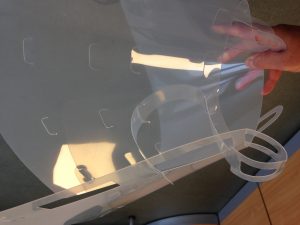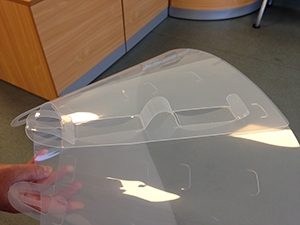Click on the links below to find out more.
How do I lift my dog if it is struggling to walk?
A harness is a very useful “handle” for lifting the front end.
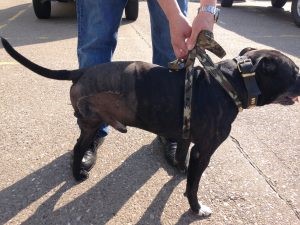
The towel belt from a dressing own or a broad leather belt can make useful loose loops to function as slings for under the tummy to help lift the hind quarters. These are better than using towels, as they are easier to hold and less likely to slip out of your hand.
See our "how to correctly transport pets" information sheet here (PDF)
How can I get my dog to feed from a height?
Some dogs with long term oesophageal and swallowing problems – e.g. patients with megaoesophagus, which remains present after vascular ring anomaly surgery – need to be fed from a height long term.
Feeding pups from height can be done as shown:
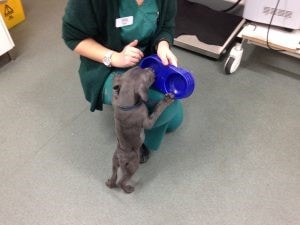
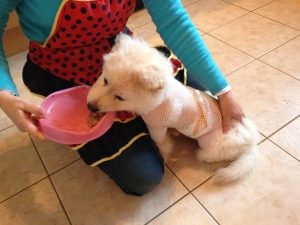
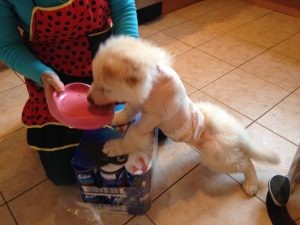
For adult dogs, you can buy food/water bowls that are elevated on a stand and train the dog to eat in a seated position so that the oesophagus slopes down from the mouth to the stomach. If your pet is resistant to eating seated, you can achieve the same effect in the standing dog by having the bowl even higher and putting a step – an aerobic exercise step works well for big dogs – in front of the bowl so that the dog has to put its front feet up on the step to reach the bowl.
Is bruising after surgery normal?
Some surgeries bruise and swell post-operatively. Some cruciate ligament surgeries do this.
The key things to look for are:
- Is your pet still well in themselves and eating well?
- Is there any discharge from the surgical wound?
- If the surgical wound is an orthopaedic one, is the leg capable of weight bearing?
- If in doubt, take a picture and email/text it to us.
The picture below was taken 2 days post-op after a cruciate ligament surgery, done with a bone cutting technique (closing wedge TPLO). This one has bruised and swollen more than most, but there is no discharge and we expect this to settle down over the next few days. So, a simple picture emailed through, and a phone conversation was all that was needed.
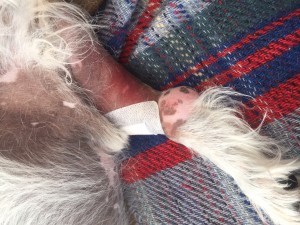
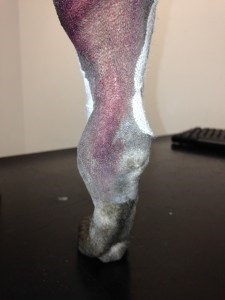
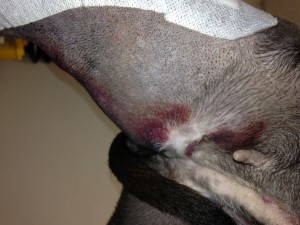
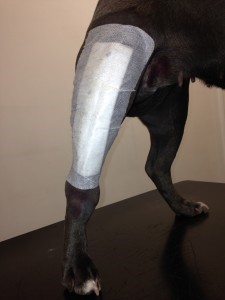
Does my pet need hydrotherapy?
Some cases really benefit markedly from hydrotherapy – e.g. femoral head and neck excision.
Many cases can benefit from hydrotherapy – e.g. cruciate surgery.
In some cases, hydrotherapy is specifically NOT recommended e.g. total hip replacement.
The aftercare sheet we will have given you very often specifies whether hydrotherapy is recommended after the surgery your pet has had. It will often have been discussed during the consultation. The wounds must be well healed before hydrotherapy, and this means no hydrotherapy at least until we’ve seen you at 2-3 weeks post-op. We see almost every case back at this time. If in doubt, ask us!
How can I restrict my pet’s activity?
- Stair gates: These are very effective in preventing access to stairs or to rooms. If your pet is normally allowed to climb onto chairs etc, or if it has a favourite windowsill to climb onto, consider keeping the door to that room firmly closed, and hang something on both sides of the door handle to remind you to shut it.
- Use a lead: This can be a good way to restrict a pet’s activity and can also be considered for cats, using a lead and harness (rather than a lead and collar). For pets with neck injuries, it is recommended that you use a harness rather than a collar.
- Assist your pet into and out of cars: Use ramps or provide a helping hand under the pelvis on the way up, and a helping hand on the breastbone on the way down.
- Consider using a cage: Cages that are approximately 36″ long (90-100cm) work well for cats and small dogs.
- Keep your pet’s playmates calm and under control: Keeping other pets and family members calm around your pet can help avoid your pet taking part in any activities that might impact on their recovery.
Should I clean my animals wound?
As a rule, no. Gentle blotting of any discharge with a dry, clean, non-linting cloth like a clean tea towel or kitchen roll is a good idea. Avoid cotton wool. Avoid rubbing. If you wet the wound you may make it look cleaner to the naked eye, but you are actually turning bacteria on the skin and any discharge into a soup that is then washed back into the wound. If there is discharge, seek advice. Consider sending us a digital photo to [email protected]. Two particular wounds that can often look a little crusty in the early stages are ear wounds, and perineal urethrostomy wounds in male cats that have had surgery for an inability to pass urine. These wounds should be left alone other than blotting. They will look much better after suture removal!
Why does my pet lick at the sutures and what should I do about it?
Licking at the wound can result from clipper rash, which is skin irritation caused to the skin during wound preparation. Licking might also reflect suture irritation; sutures may become a little tight if the wound swells at all. Discharge, sometimes indicating infection, can encourage licking as normal cleaning behaviour. But licking can be destructive, and it is best avoided. Seek prompt advice if licking persists. We may use dressings or collars to prevent licking causing damage to the wound.
How would I know if a wound was becoming infected and how likely is infection?
Discharge, especially smelly discharge, from a wound is cause for concern. Infection often causes increased interest in the wound with licking noted. Your pet may be off-colour and declining food.
Infections are not likely at all. We are scrupulous in our standards of disinfection and hygiene, and in preparing wounds for surgery. We strive for zero-infection rate, but the sad reality of surgery is that this elusive goal is never quite reached. Infection risk in otherwise routine surgery is often quoted at around 2%.
My pet hates the Elizabethan collar. Is this normal?
Let’s be honest, your pet isn’t likely to want the collar on! But consider the consequences of the collar coming off. It is usually best to put it on and leave it on. They can often be cleaned in situ with a damp cloth without the need for removal. Let them get used to the collar, have their moment of annoyance, and then come to terms with wearing the collar. If you keep taking the collar on and off, the pet gets frustrated because it thinks the collar is a punishment and they don’t understand what they’ve done wrong. If you take the collar off, they are back to square one, having to get used to it all over again. Most animals can eat and drink just fine with these collars on, even though at first it might look impossible. An alternative to an Elizabethan collar is an inflatable one which may be adequate to protect wounds from licking in some cases.
What alternatives to Elizabethan collars are there?
Inflatable collars are one alternative to the classic “Elizabethan” collar or “lampshade” collar, to prevent licking. They don’t stop licking as effectively in our experience, but they are usually better tolerated by the patients. They need to be kept well inflated! An inflatable collar can be used behind a shorter/smaller Elizabethan one than might otherwise be used. The inflatable collar can keep the smaller Elizabethan collar well forwards, whereas otherwise the shorter one might ride backwards on the neck, rendering it ineffective.
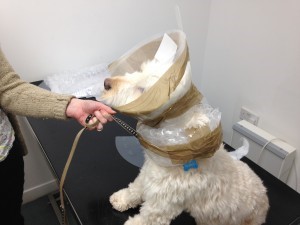
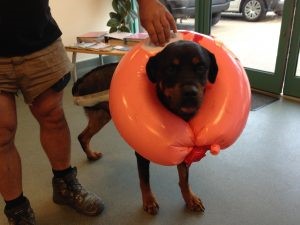
T-Shirts or home-made vets made out of fleeces and tights have been used by many of our clients, to avoid Elizabethan collars. You can buy these from suppliers like Equafleece.
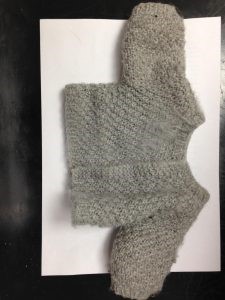
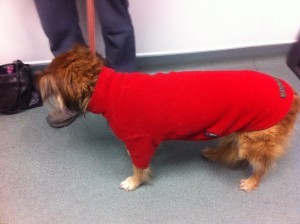
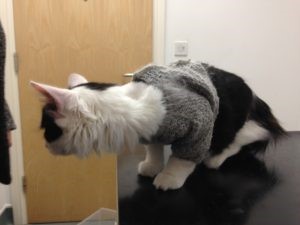
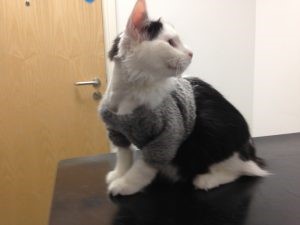
A dressing has been put on. How do I look after it?
Don’t let the dressing get wet. Walk your pet on pavements, on paths or on well mown, dry grass, not muddy fields! For limb dressings, use a thick polythene bag over the end of the limb during toilet breaks. We often give out drip bags (bags that have previously had saline in them). If these are cut in half and the inside is dried out, they make for strong “wellies”. Parcel tape is handy for keeping the bag up for the few minutes that they need to be on. But don’t leave bags on for more than a few minutes at a time, as they keep moisture in as well as out. That means that if they are left on for long periods, the foot will become sodden anyway.
Some animals urinate on dressings by mistake; to guard against this, you can place a bag over the foot as above, and then wrap the dressing that is still exposed above the bag with cling film. This can then be removed a few minutes later after the toilet break.
If the dressing slips, get it seen to. A slipped dressing is an irritation to your pet, is no longer protecting or immobilising what it should be protecting and may even be increasing the leverage on injured bones/joints. The great majority of our dressings are put on so that you can just see or feel the claws at the end of the leg. If you could see them, but now can’t, the dressing has probably slipped.
Make sure the dressing is changed at the appropriate interval. If you can’t remember when, please ring and ask!! Usually dressings are removed and/or changed every 3-7 days. Sometimes we’ll leave them on a bit longer, but it would be very unusual for the interval to be more than 10 days.
Most dressing changes can be done conscious while you wait. For some more feisty pets, sedation may be needed so it would be wise not to feed your pet for a few hours before a dressing change, just to be on the safe side.
For some surgeries, a dressing incorporating a splint, or a cast is used, often for several weeks.
Animals will often try to pull the padding layer out of a dressing if they are given half a chance, so please be pro-active in using an Elizabethan collar to prevent interference with the dressing.
Dressing sores will unfortunately occur from time to time. These are more common if the dressing is allowed to get wet; if the dressing incorporates a splint or cast; if the dress is maintained for several weeks; if the dressing slips; or if the dressing is interfered with. These sores usually resolve uneventfully once the dressing is removed.
Many surgeries will simply have a thin Primapore dressing over the site. This is a thin white dressing. If the wound is exudating, it will be obvious through the dressing which will be wet. If this occurs, let us know promptly. Many wounds will leak the odd spot of blood or tissue fluid immediately post-operatively, but in this case the evidence of exudate will be minimal, dry, and the Primipore will look the same every time you look at. Be wary of trying to replace the Primpaore yourself unless advised to do so. We glue ours on, and it is unlikely that you’ll be able to get a replacement to stay on long at all.
We advise that you just leave the Primapore alone and let it fall off in its own good time. This often occurs in 2-3 days, which is fine. The record is currently held by a post-op spine patient who kept his original Primapore on for 4 weeks before even we got impatient and took it off!
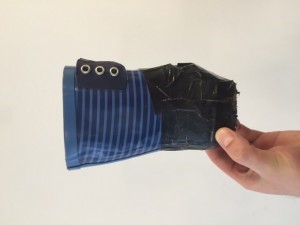
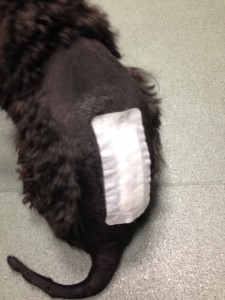
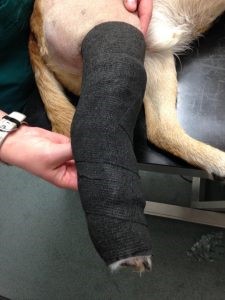
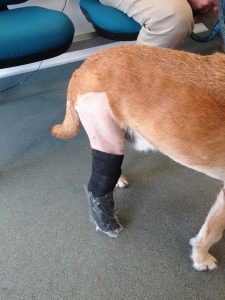
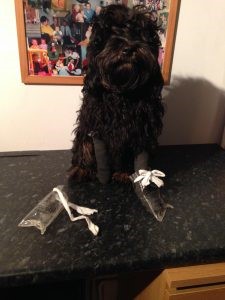
Could there be a problem with the metalwork in my pet’s leg, long after surgery?
Pins and wires, and screws and plates, can sometimes be the cause or irritation months or years after surgery. If this happens there will often be swelling and/or licking at the site. Removal of the metalwork usually leads to rapid resolution of the problem.
Why can’t I get further medication from West Midlands Veterinary Referrals?
Our fixed price packages include an initial supply of drugs that typically last five days.
We usually supply antibiotics (clavaseptin), non-steroidal anti-inflammatories (NSAIDs, usually carprofen or meloxicam), and often extra analgesia (tramadol for dogs and buprenorphine for cats).
As policy, we ask that further medications are sourced from your referring veterinary practice. As a surgical practice our drug stock is far more restricted in range and quantity than is the case for a typical general practice.
My pet hasn’t passed motions since surgery. Is this normal?
Eating and drinking should be occurring pretty much as soon as you get your pet home. Your pet will normally have been observed to eat and drink in the hospital before discharge, although some animals, especially cats, simply refuse to eat in a strange environment. Urination should have occurred in the first 12-24 hours after discharge. If it hasn’t, we need to know promptly! The bowels often grind to something of a halt with a general anaesthetic and with the opiate drugs that we give for pain relief around the time of surgery. Add to this the starvation before anaesthetic / surgery and reduced appetite post-operatively (or enforced with-holding of food in some cases), and it can take a few days for defaecation to normalise.
How do I do the extension exercises after femoral head and neck excision surgery?
Passive extension exercises are required in the two months following this surgery. We recommend 3 sessions of 5 minutes each per day, for two months. Giving your pet pain killers over this time will make life a lot easier for them and for you.
Femoral head and neck excision (FHNE) involve removing the ball of the hip ball-and socket joint, usually with an oscillating saw. As healing progresses, a fibrous tissue articulation develops to replace the joint. Diligent physiotherapy and/or hydrotherapy is needed in the following two months to keep this pseudoarthrosis (“false joint”) articulation flexible to achieve a decent range of long-term extension. One major benefit of FHNE over almost every other orthopaedic procedure is that there is no need to restrict activity in the post-op period. Activity, including stair climbing etc, is very much encouraged. See our post-op aftercare sheet for FHNE for more detail.
This surgery is vastly cheaper, less technically demanding and less complication-prone than total hip replacement. Indeed, when THRs do get serious complications, they often get revised to FHNEs. The function that is achieved with FHNE is usually more than adequate in cats and small dogs. FHNE is generally less adequately functional the larger the patient gets. That having been said, good outcomes can still be achieved in larger dogs.
Common indications for FHNE include:
- Luxation of the hip joint(s) secondary to hip dysplasia where hip replacement is not an option.
- Chronic degenerative joint disease failing to respond to medical management where other surgical options have been ruled out.
- Fractures involving the joint where fracture fixation is not possible /desirable or is ruled out by economic considerations.
- Legg Perthe’s disease, typically seen in young terriers. One or both femoral heads lose their blood supply and disintegrate. Legg Perthe’s disease is painful.
These images show how to do the extension exercises:
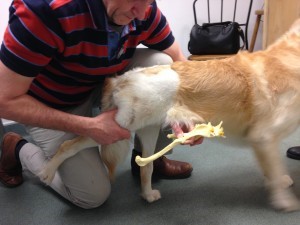
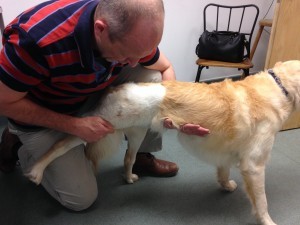
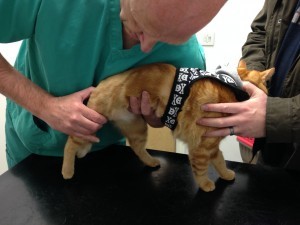
How can I help my pet walk after spinal surgery?
Slings can be bought, or they can be improvised from a leather belt, a scarf or an old bath towel. Helping your pet to balance, while letting them take much of their weight, can be very useful. Keep your own back straight when you are lifting them!
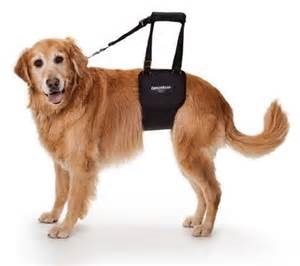
Regular short periods of lifting, every 2-3 hours, are better than less frequent periods of lifting. If intervals are longer muscles stiffen up and cramp.
Partly inflated Pilates balls can be useful for big dogs. Straddle the dog over the bag and gently rock left and right, forwards and back to encourage them to make decisions about weight bearing and adjusting posture.
Your pet should be regularly alternating how it lies, and on which side. Hydrotherapy is really useful, as is advice from one of our recommended physiotherapist / hydrotherapists. Short, dry grass, rubber matting or rough carpet is an ideal surface for early walking attempts. The texture is good for stimulating sensation, while providing some grip and cushioning.
Take great care that your pet doesn’t traumatise the top surface of their feet on hard surfaces. Steps made out of paving slabs are a nightmare for this as they have very sharp and unforgiving edges. To screen off these edges, get some foam pipe lagging material from a DIY shop, slit it long ways and stick it with duct tape over the edge of the step.
Tickling the toes with an electric toothbrush is a good way of stimulating sensation.
For large dogs, a frame supporting a sling can be very useful to take the dog’s weight while the individual legs are worked on.
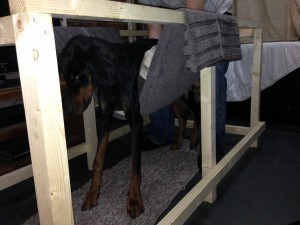
My pet has an external fixator; what do I need to do?
Some orthopaedic procedures involve the use of an external fixator see photo which involves pins protruding from the skin connected to a scaffolding that links them. Some minor discharge from the pins is normal. Blot any discharge gently with non-linting material once or twice a day and don’t bathe the wounds. It is very important that the frame doesn’t get hooked on to carpets, tassels on furniture, curtains, the bars of cages, under radiators etc. If your pet escapes from the house, there is a pretty good chance the frame will get hooked on a fence so keep them in!! Consider the use of a cage. Consider screening off the bars of the cage with cardboard or hardboard inside the cage. The sharp ends of the pins often concern owners because they fear that the sharp pin ends will prang the other leg. Animals very quickly learn to avoid doing anything that hurts! However, the sharp pin ends pose quite a risk to your hard-earned furniture. Please take precautions before bits of wood get gouged out of favourite chair legs etc!
The clamps, (the bits with nuts and bolts which connect the pins coming out of the leg to the connecting bars), should be well clear of the skin. if you can’t see “daylight” between the clamp and the skin, get advice. You can bring the patient for a recheck, or you might consider taking a photo and emailing or texting it to us, and then giving us a call.
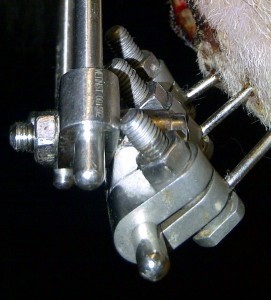
How do I put an Elizabethan collar together?
